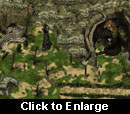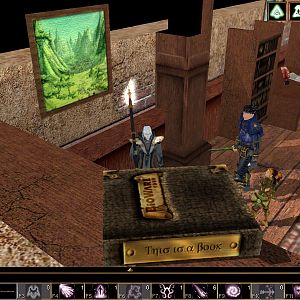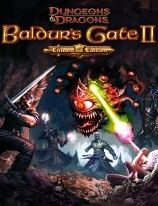-

- Forums
- Chatrooms
- Gallery
- Gameplay Videos
- Upload
- Articles
- Mod Reviews
- Shop SP: Games, Movies, Books

|
You've defeated hordes of undead, searched high and low for the dreadsword daemonic, and talked to countless ghostly remnants of the once-proud people of Myth Drannor to aid you in your ultimate goal... all the while patting the trusty map cases at your side and thanking the gods for your luck in discovering them. In Pool of Radiance: Ruins of Myth Drannor, heroics are largely determined by your ability to navigate catacombs, dungeons, and overgrown terrain as you seek the next band of evil minions to slay or glorious treasure to unearth.
 The game features a three-quarters isometric view of the Forgotten Realms city of Myth Drannor. Quests take players to diverse environments, from the overgrown gardens in the northern portion of the city, to the swamp-infested eastern reaches, to the crumbling steps near the Hall of Wizards. Players soon realize the importance of the in-game map, which allows them to see where they have already traveled and where they still need to go. Each level of the game has its own map, which includes interiors (like the Hall of Wizards and the dwarven stronghold known as the House of Gems), underground complexes (such as the elven catacombs, lizardfolk tunnels, and subterranean reaches under Castle Cormanthor), and, of course, the aboveground map of Myth Drannor. Players can freely change between the overland map and specific maps for areas they are presently in.
The game features a three-quarters isometric view of the Forgotten Realms city of Myth Drannor. Quests take players to diverse environments, from the overgrown gardens in the northern portion of the city, to the swamp-infested eastern reaches, to the crumbling steps near the Hall of Wizards. Players soon realize the importance of the in-game map, which allows them to see where they have already traveled and where they still need to go. Each level of the game has its own map, which includes interiors (like the Hall of Wizards and the dwarven stronghold known as the House of Gems), underground complexes (such as the elven catacombs, lizardfolk tunnels, and subterranean reaches under Castle Cormanthor), and, of course, the aboveground map of Myth Drannor. Players can freely change between the overland map and specific maps for areas they are presently in.
 Perhaps the best feature of this steering device is the ability to annotate the map: Players can "flag" areas of the map with text notes to remind themselves about locked doors, traps, creatures, and so on. With more than 15 individual maps and 8 large aboveground zones on the main map, the ability to keep notes proves a blessing. A variety of forces are at work in Myth Drannor -- scores of orog, lizardfolk, cult soldiers, drow, and gargoyles, all of whom have set up strongholds in certain locales. However, borders in a finite amount of space sometimes bleed into each other, and players might experience instances where bloody feuds have broken out amongst the denizens of this dark place. One side could ask for their assistance over the other in exchange for rewards or safe passage through dangerous areas of the game. Noting what types of creatures seem to gravitate toward certain areas could prove a useful tactic in developing battle strategies or making choices in dialogues.
Perhaps the best feature of this steering device is the ability to annotate the map: Players can "flag" areas of the map with text notes to remind themselves about locked doors, traps, creatures, and so on. With more than 15 individual maps and 8 large aboveground zones on the main map, the ability to keep notes proves a blessing. A variety of forces are at work in Myth Drannor -- scores of orog, lizardfolk, cult soldiers, drow, and gargoyles, all of whom have set up strongholds in certain locales. However, borders in a finite amount of space sometimes bleed into each other, and players might experience instances where bloody feuds have broken out amongst the denizens of this dark place. One side could ask for their assistance over the other in exchange for rewards or safe passage through dangerous areas of the game. Noting what types of creatures seem to gravitate toward certain areas could prove a useful tactic in developing battle strategies or making choices in dialogues.
 In their travels, player characters also happen across notes, journal entries, marching orders, and other missives that have been left behind, pillaged, or discarded. These pieces of parchment help immerse players into the game world by enhancing storylines, hinting at routes to take, and suggesting areas where caution may be warranted. Signposts also exist, especially in the dwarven dungeons, to point out sites of note or importance. Players can flag these areas to remind themselves, for example, that north leads to the remnants of an inn overtaken by orcs, while southwest takes one into the main square.
In their travels, player characters also happen across notes, journal entries, marching orders, and other missives that have been left behind, pillaged, or discarded. These pieces of parchment help immerse players into the game world by enhancing storylines, hinting at routes to take, and suggesting areas where caution may be warranted. Signposts also exist, especially in the dwarven dungeons, to point out sites of note or importance. Players can flag these areas to remind themselves, for example, that north leads to the remnants of an inn overtaken by orcs, while southwest takes one into the main square.
Travel, incidentally, doesn't always mean footing it through rubble and slimy dungeons. Later in the game, a magical device known as the orrery allows players to cruise strands of magic upheld by the power of the Mythal. Given the size of the ruined city, new adventurers might find themselves disoriented while using such a device. But with their trusty maps available, characters can employ the orrery to cut down on time lost simply moving between places, enabling them to devote more time to discovering and dealing with the disturbance concerning the new pools of radiance.
Knowing where you have left to go and what areas you've already cleared out is an essential part of any roleplaying game. An adventuring party had best stay alert to new areas since unknown dangers could be formidable. In the end, it will be that old, worn-out map stuffed deep in the reaches of your backpack that leads you to your ultimate battle with fate. Now... was it right or left at the fork up ahead to breach the battlements of Castle Cormanthor's outer wall?


